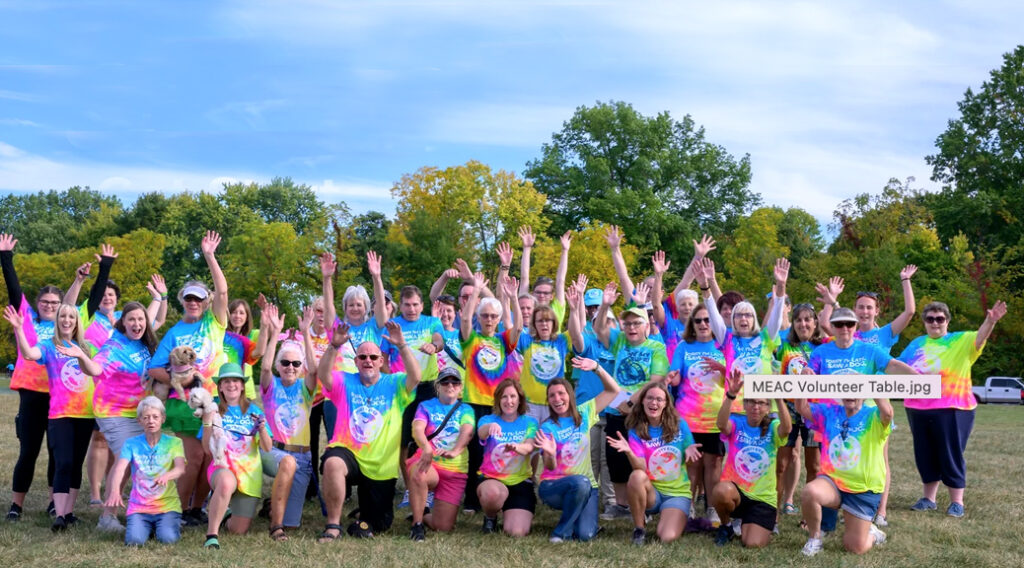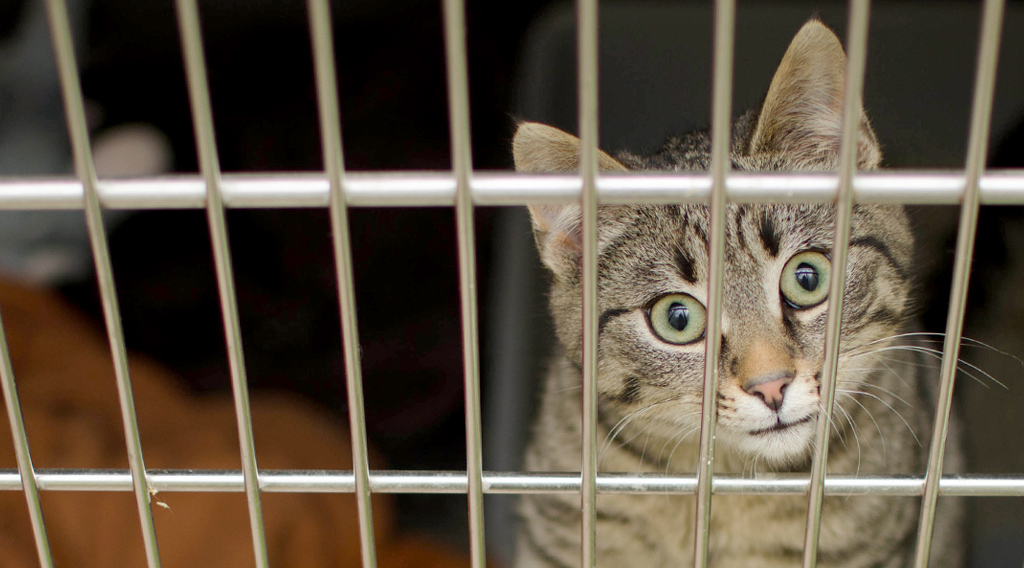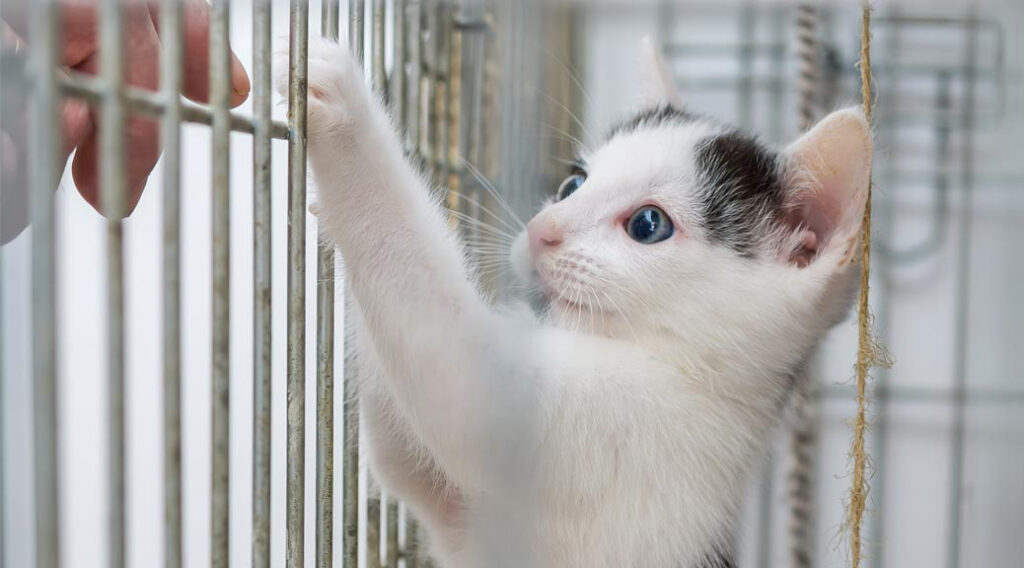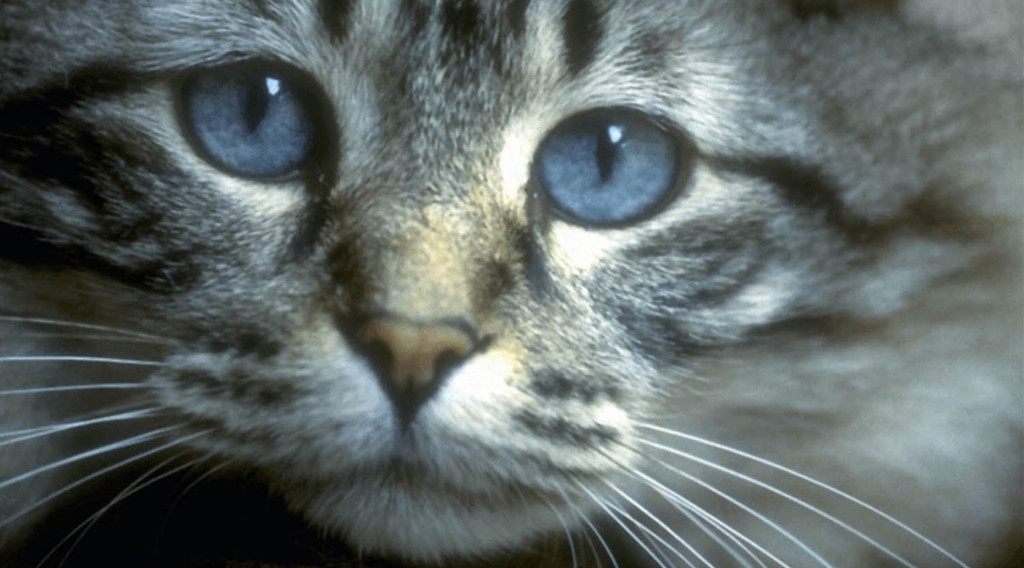June is National Foster a Pet Month, set aside to recognize the contributions foster caregivers make to animal welfare by providing temporary homes for rescued pets while freeing space in shelters.
Based in Avon, Misty Eyes Animal Center is an all-volunteer organization that relies on a network of about 115 foster homes—mostly in Hendricks County and western Marion County—to care for rescued animals from throughout our community, region and state.
Cherie Fox and Renee Harlor founded Misty Eyes in October 2011. Last year, the group rescued 652 animals.
Currently about 75 volunteers are actively fostering one or more pets rescued by Misty Eyes. Another 20 or so qualified foster caregivers are “on pause” right now, taking a break from fostering for a variety of reasons. Most will resume fostering as soon as they’re ready to take in the next animal.
There are nine foster homes providing sanctuary care for 19 animals who have proved to be unadoptable for medical or behavioral reasons. Because of these foster volunteers, these cats and dogs have permanent homes, despite their issues, for life.
Another seven foster families provide respite foster care when needed.
There are an additional 120 Misty Eyes volunteers helping with a variety of essential tasks to rescue, manage and place animals and maintain the organization’s expanding facility at 616 South County Road 800 E.
With the opening of their Kitty City building on January 30, 2025, Misty Eyes has expanded its accommodations beyond foster placements to save even more cats.
While still primarily a foster-based rescue, Misty Eyes now can house cats in Kitty City when foster home space is unavailable. During the facility’s first three months of operation, Misty Eyes had 36 older kittens and adult cats adopted directly from Kitty City. Given that adult cats are traditionally more difficult to rehome, having the ability for the public to meet and interact with cats in Kitty City has been a wonderful enhancement to Misty Eyes placement efforts.
Brownsburg Animal Clinic has been a longtime supporter of Misty Eyes Animal Center, participating in special events and offering discounted fees for the rescued animals’ veterinary care.
“Brownsburg Animal Clinic has been with us from the beginning,” said co-founder Fox. “In our time working together, we’ve grown to trust them to give us sound advice and excellent care to every animal we bring in for treatment.
“We couldn’t do all we do for our rescues without that relationship.”
There’s No Place Like Home
Even the best-run animal shelters can be lonely, stressful environments for displaced dogs and cats.
The individual attention rescued animals receive in foster care gives them an opportunity to relax in a home environment, recover from any illnesses or surgeries, relate one-on-one to loving caregivers and other pets and learn the life skills they need to succeed in adoptive homes.
Foster caregivers get to know the animals as they help them adapt to home life. The information they provide about the fostered pets’ emerging personalities helps adoption counselors match them with potential adopters.
Jennifer McCarty, now a Misty Eyes vice president, has volunteered with the organization almost from the beginning.
“I’ve been a volunteer for the past 11 years,” said McCarty, “and I’ve been fostering the whole time. At this point, I don’t know how many dogs and cats I’ve fostered. I know it’s a lot. Maybe hundreds.”
McCarty said the need for more foster caregivers is constant.
“Shelters are more packed than ever right now, and Misty Eyes always needs more foster homes,” she said. “Having more approved foster homes available means we can take in more dogs and cats and puppies and kittens when they need us most.
“For some of them, the foster home can make the difference between life and death.”
The Rescued Pets
The animals Misty Eyes rescues are strays, owner-surrendered pets and homeless pregnant animals’ puppies and kittens. Some come directly to Misty Eyes and others are “pulled” from overcrowded shelters.
“There’s always a steady stream of animals,” McCarty said, “and we stay at capacity based on what our approved foster homes are able to take in.”
Misty Eyes retains control and guardianship of fostered pets, providing food, supplies, toys and veterinary care. According to the Misty Eyes web page on fostering, “Fosters provide the love. Misty Eyes provides the rest.”
“We have an area at our center in Avon where our fosters come to pick up supplies—food, collars, leashes, crates—anything they need,” said McCarty. “If an animal needs prescription food or some other special equipment or supply, we order that in and have it ready for the foster to pick up.”
The length of time a pet remains in a Misty Eyes foster home varies.
“The typical animal that comes in with no major medical problems, I’d say stays with us a month or less,” McCarty said. “A pregnant cat stays at least three months.
“Animals with temporary medical or behavioral concerns won’t be advertised as available until they’re ready for adoption,” she added.
Occasionally, animals have problems that can’t be resolved well enough to offer them for placement in permanent homes.
“We’re not an animal sanctuary,” McCarty explained, “so we don’t deliberately bring in animals that can’t ultimately be adopted.
“But from time to time, we’ll take in an animal with a medical or behavior problem we didn’t realize was there. It turns out they’re not adoptable and will need to continue indefinitely in foster care.”
As examples, McCarty cites a dog with a heart condition who lived with a Misty Eyes foster caregiver for seven years. Another dog who “doesn’t like other animals” has proved difficult to place. “She’s been with Misty Eyes almost as long as I have, but we haven’t found the right home for her. She’s lived happily with her foster family for so long now, she’s probably there for life.”
What It Takes To Foster
To qualify to foster, McCarty said, “You need to love animals and be willing to care for them responsibly, as if they were your own.”
Becoming a foster caregiver for Misty Eyes begins with completing a detailed online application form.
The screening questions are thoughtful and thorough, reflecting expectations clearly and demonstrating just how seriously the organization takes its role and responsibilities as guardians of the animals in its care.
In addition to asking questions about multiple aspects of potential home life for a fostered pet, the foster application offers a checklist the applicant can use to list experience caring for senior dogs and cats, untrained dogs, injured animals, puppies, kittens and pregnant dogs or cats.
Applicants are also asked to indicate the types of dogs and cats they are willing to foster according to gender, size, age and special needs such as heartworm treatment, surgery recovery, blindness, deafness and pregnancy.
The application concludes with a comprehensive series of specific requirements to which the aspiring foster caregiver is asked to agree, one by one. Among the requirements:
- The applicant affirms they have never been charged with or convicted of animal cruelty.
- They agree to keep the pet indefinitely, with no guarantee of how long they will be asked to foster.
- They agree to “provide a safe, comfortable and healthy environment for their foster pet(s).” This section of the agreement further stipulates, “Our foster dogs should be indoor dogs, and should be exercised and socialized in such a way as to create a positive, well-tempered dog. Foster cats are always to be indoor cats for their safety. Both cats and dogs should be fed healthy food, which will be provided to you, and given appropriate access to water.”
- Applicants agree “to work with Misty Eyes for medical treatment of the foster pet.” Misty Eyes pays for fostered pets’ medical care, requiring foster caregivers to seek veterinary care only from approved veterinarians, and only after giving prior notice to Misty Eyes “to ensure finances and treatment options are appropriately aligned.”
- Prospective foster caregivers agree to help Misty Eyes promote the adoption of their fostered pets by bringing them to adoption events and to the adoption center in Avon to meet prospective adopters.
- Foster caregivers agree to treat the animals they foster as if they were their own pets, ably handling all routine care and any pet-related issues that come up. “As a foster family, you should operate within the fostering guidelines set forth by Misty Eyes, and while you do not own the pet, you should treat the pet as if it were yours.”
- Foster caregivers agree “to provide regular updates on the status and progress of the foster pet(s), and to inform us immediately of any health issues or behavior problems.” Misty Eyes ultimately determines how to respond to reported issues and problems.
The foster application continues with a brief description of the centralized screening process Misty Eyes uses to handle applications from individuals and families interested in adopting a pet. If the adoptive applicant passes their initial screening and appears to be a potential match for a particular fostered pet, the Misty Eyes adoption team notifies the foster caregiver and arranges “meet and greets” between the prospective adopter and the fostered pet.
Misty Eyes encourages foster caregivers to recommend potential adopters interested in giving a foster pet a permanent home, stating, “If you have a friend, family member, neighbor or acquaintance who may be interested in adopting the pet, please direct them to complete an online adoption application to start the approval process. We always welcome the foster family’s recommendations, if they know the potential adopter.”
Jennifer McCarty said some foster caregivers eventually themselves adopt an animal in their care, “but not a high percentage.” In her 11 years of fostering hundreds of animals, she is just now preparing to adopt her third fostered dog.
To address those situations, the foster application contains a clause advising prospective foster caregivers to “Notify us immediately if you would like to adopt your foster pet. Once external applications have been received and processing has begun, the foster family cannot be given preference.”
Further requirements detailed in the foster application include never turning the pet over to anyone not connected with Misty Eyes, keeping dogs on-leash outside enclosed areas, keeping a Martingale collar with a Misty Eyes tag on dogs at all times, and working with dogs on basic obedience commands and house manners. If needed, Misty Eyes will arrange basic obedience training for fostered dogs.
The application concludes with a detailed liability release and waiver.
Application Follow-Up
If the foster application is approved, the Misty Eyes foster team follows up with a phone call and a home visit.
“The foster team explains how the foster program works, answers any questions and looks around the home for any safety concerns—like a gap in a fence—that need to be fixed before we place an animal,” McCarty said.
“Our team members also get to know the foster’s pets and start thinking about what pets we might match with them.”
From time to time, pets need to be relocated from one foster home to another.
“We do our best to make good matches, but occasionally we have to move a pet,” McCarty said. “Sometimes it takes a few dogs or cats to go through and figure out what works well in that particular home.”
Some caregivers develop specialties in caring for pets with particular needs. “Certain fosters are wonderful with pregnant cats or bottle-feeder kittens,” said McCarty. “Others do great fostering puppies, and we have fosters who are great with senior dogs.
“We do have fosters who definitely have their niche, for sure.”
Is Fostering For You?
Misty Eyes recruits new foster caregivers primarily through word-of-mouth from current caregivers and occasional notices on Facebook. However you hear about the opportunity to foster, if you are seriously interested in serving as a foster caregiver to animals in need, Misty Eyes will welcome your foster application.
McCarty said many animal lovers mistakenly hesitate to apply, believing they can’t foster pets if they have a full-time job or have pets of their own. “If we required that, we’d have very few foster homes,” she said, adding she herself has her own pets and a job in addition to her fostering and other volunteer work for Misty Eyes.
A good way to get started, once your application is approved and the home visit is done, is to be a “vacation foster” who fills in for foster caregivers who need to be away from home temporarily.
“Vacation fostering is great way to get started for somebody who’s not quite ready to take on a commitment to be a full-time foster. Their help is super-valuable, and we need them”
As fostering gets underway, the Misty Eyes foster support team contacts the caregivers at scheduled intervals to make sure things are going smoothly with the pet. “We also have online update forms the fosters can use to keep in touch,” added McCarty.
Foster caregivers can participate in online workshops covering animal care basics as well as behavior training. Misty Eyes will schedule one-on-one coaching sessions with a trainer as needed to help fosters teach basic commands and resolve behavior problems.
In addition to its public Facebook page, Misty Eyes maintains private Facebook groups for fosters and volunteers to exchange information and build community.
Letting Go
Many beginning caregivers worry they will form such strong attachments to the pets they foster that they’ll have trouble letting them go to their adoptive homes.
“Some are harder to let go of than others,” admitted McCarty. “You can feel stronger attachments to the first or second ones you’ve fostered or the ones who’ve been with you longer. But it does get easier.
“You just have to focus on the next animal that needs you and know in your heart, from the beginning, they’re going to move on. You’re that bridge to get them from where they are to where they need to be.
“It also helps to think about how happy this animal will make someone else.”
As an example, McCarty told the story of “the chihuahua that got away.”
“I wanted her so bad, but I didn’t keep her. I let her go. She was adopted by a lady whose husband later had a stroke. The dog went with her every day to see him and lay on his bed with him, all day long, until he died.
“The husband needed the dog to comfort him as he was dying, and the lady needed that dog’s companionship and unconditional love after her husband died, more than ever. It feels good to know the part I played in caring for that dog and how much she ended up meaning to her adoptive family.”
McCarty continued, “For me, fostering has been life-changing—not just for the animals, but for myself as well. Wanting to help these animals has become such a big and important part of my life, and some of these animals really have changed me as a person.
“Besides teaching me so much medical and behavior training knowledge, they’ve given me a purpose, for sure. Animal rescue has definitely become part of my identity.”
Other Ways You Can Help
If you are unable—or not quite ready—to foster a rescued pet, you can still support the work of Misty Eyes Animal Center in a number of vitally important ways.
Volunteer. On their website’s Volunteer page, you’ll find details of current openings for volunteers to help with community outreach, special events and staffing the center’s office and welcome desk. Links to application forms for adult and junior volunteers are on the page.
Donate supplies. To donate most-needed supplies, visit the Wish List page. There you’ll find lists of supplies needed for animals, along with building maintenance and office supplies for the center. There are also links to online wish lists at Amazon and Chewy.
Donate money. On the Misty Eyes website’s Donate page, you’ll find options to make a one-time gift, a recurring monthly gift or a tribute or memorial gift. Scroll down to see options for corporate sponsorships and naming opportunities for shelter construction projects on the Misty Eyes campus.
Adopt a pet. If you’re interested in adopting a rescued pet, visit the Adoption Process page. There you’ll find out how Misty Eyes places pets in the best-suited adoptive homes, along with links to an adoption application form and photos of available pets.













